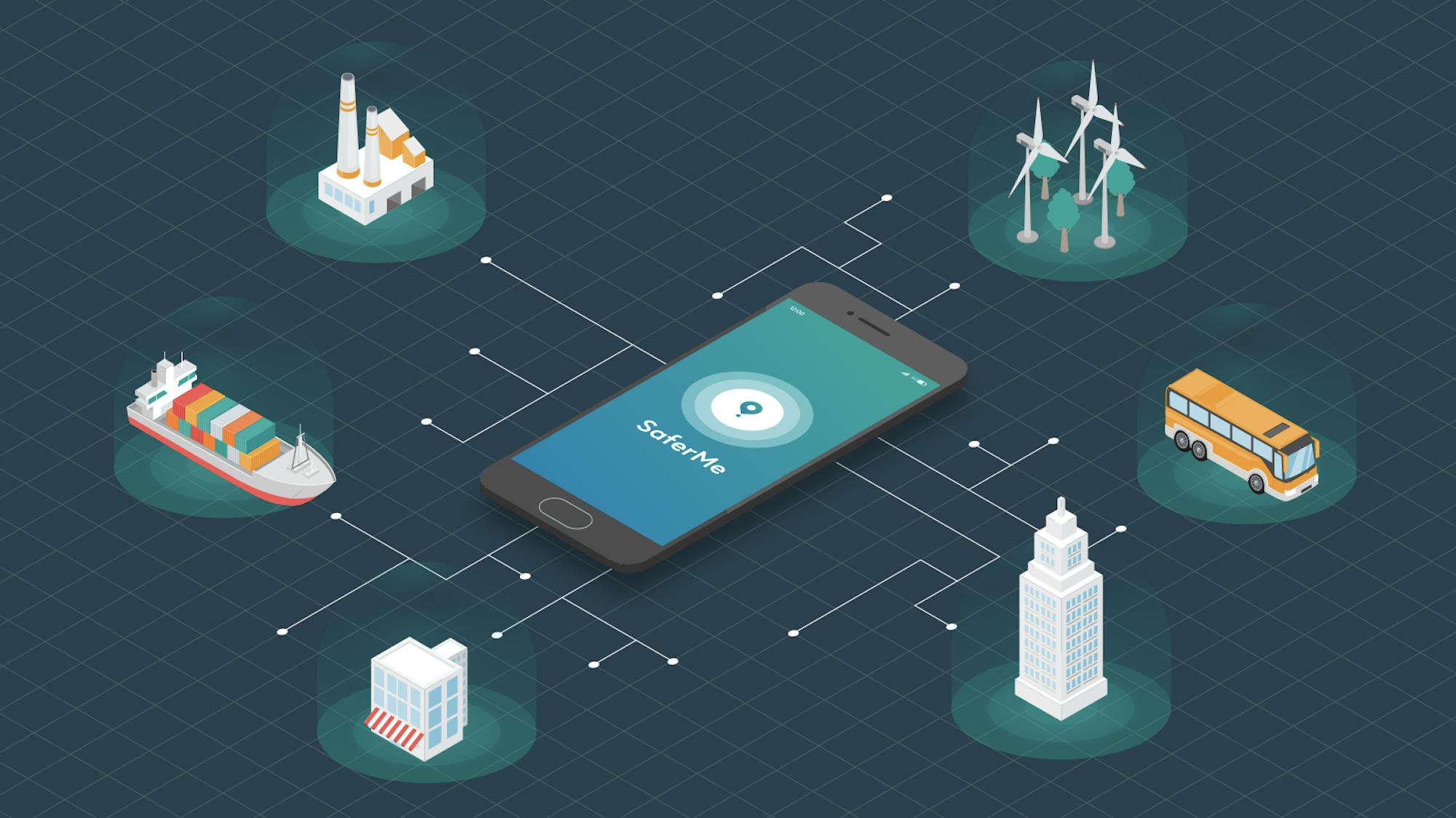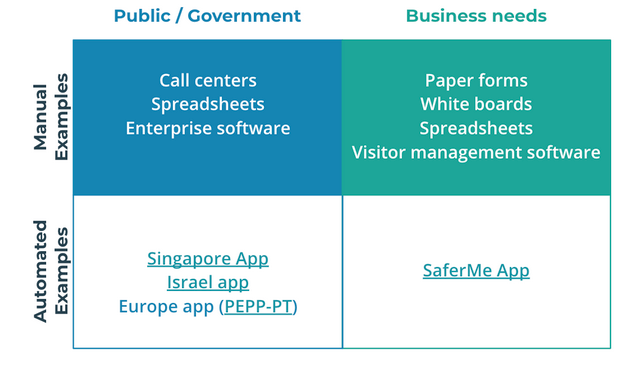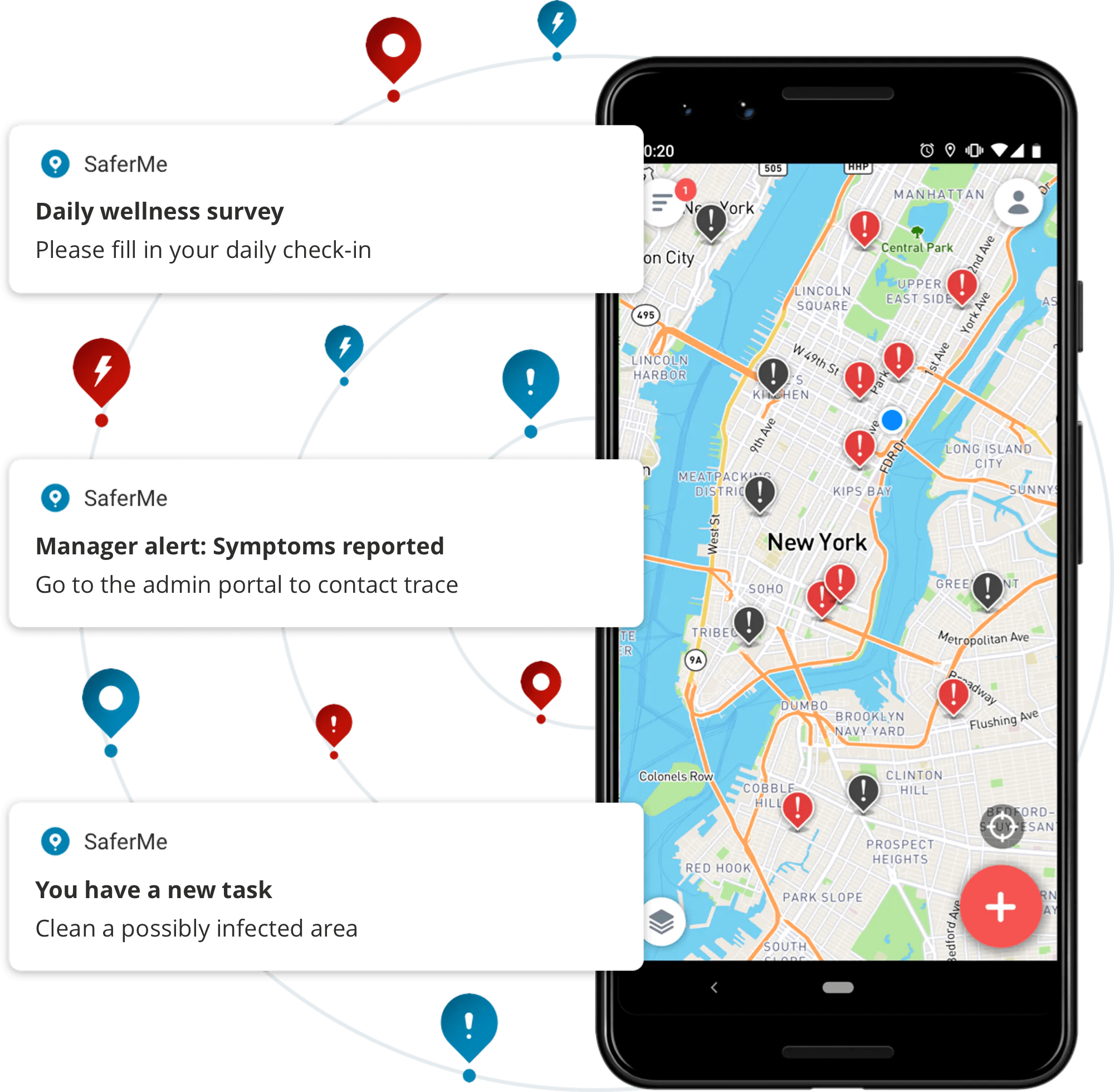
Update: Interested in comparing contact tracing tools in a simple way? - perhaps start here with this comparison table.
A number of different international projects to conduct contact tracing have been established in response to the current covid-19 pandemic.
These methods are mainly designed for adoption by broader communities and even whole nations. While others, such as SaferMe’s mobile solution, have been designed with organisations in mind - so business can minimize the potential impact of the coronavirus on their staff.

Below we explain the different types of contact tracing methods and technologies. Also we’ve added analysis on what could be the best fit for your purpose.
Manual contact tracing

Contact tracing of course doesn’t need software. For small businesses or groups, a pen, paper and good routines have been successfully adopted. I had a personal experience while visiting a tourist hotspot in New Zealand shortly before the country went into lockdown, and the restaurant we ate at took our names and contact details as part of the process when we paid the bill. Manual contact tracing can of course be digital too, but requires good routine and when considering tracking larger scale interactions, an automated solution is suggested to accompany manual processes.
Automated contact tracing (mobile GPS)

When contact tracing needs to scale up, that’s when mobile app technology can help. A flurry of mobile apps using different methods have appeared in recent weeks. One method this works is by using GPS data from the phone and in the background collecting that data for the community of users. If one of that community returns a positive test then their contact history can be shared to the administrator allowing affected contacts to be reached.This method of collecting location data is well tested and is the current method which SaferMe uses and has been using for some time, to keep workers safe from hazards.
Automated contact tracing (“Bluetooth handshake”)
In Singapore, USA, Israel and Germany solutions have been released or are under development that allow for a “bluetooth-handshake” between devices. One way to picture how this works is to imagine your mobile has a registration plate like a vehicle does. Each time you “drive” past another “vehicle” (by receiving each other’s bluetooth connection) then both vehicles note the other’s “registration plate” in a list in their own memory. Should one user return a positive covid-19 test, they can then share that list with health authorities - with some apps this may create automated notifications for the other users.
Some of the app projects currently active in this space are listed here on the Covid Watch website: https://covid-watch.org/about#comparison
Which is the best method for contact tracing?
Here there is much debate, and as with most challenges - there are many methods of contact tracing. But let’s separate into business and societal purposes to analyse the three methods.
Contact tracing in the community
The Bluetooth handshake approach is the method being used by most of the major projects underway. It still faces, however, much work to make the solution practicable. The privacy settings on Apple (iOS) devices are very restrictive, while Google’s Android device landscape is very fragmented with many different device manufacturers in its stable. There are interoperability issues between the two.
Efforts are underway to address these problems, including a joint effort between Google and Apple that aims to alleviate these issues and potentially bring some features to an operating system level.
The outcomes of that project won’t be known till mid-May at earliest; and even if there is success with that, there remains question marks about whether they will gain the trust of the majority of populations so enough people download them; and also how practicable the datasets would be to take action on. If you imagine a citizen in a city such as Tokyo, they would come in bluetooth proximity of an incredibly high number of people over a two-week period. As would each of those contacts whom they had that ‘association’ with. How long the two devices would need to be close to one another to deem an infection risk is a question also in need of resolving.
Despite these challenges, the sheer number of projects, the input of heavyweights like Apple and Google and the privacy upside of the bluetooth handshake approach make it the best fit so far for community-level contact tracing.
Contact tracing in business
Businesses also face a set of unique challenges in the coming months as they try to return to operations while the ongoing covid-19 pandemic remains a threat.
Business leaders must first consider their legal obligations to protect the wellbeing of their employees, and also the potential devastating impact of an outbreak of covid-19 within their workforce. Above these core requirements, businesses will also need to assure partners, suppliers and customers that they have good routines and reliable contact tracing processes in place so they can be seen as a safe trading partner through this time.
Due to these circumstances, a business-focused contact tracing solution is the best fit because it offers features far beyond the community-focused tracing apps being developed.
Key business features include; automated rollout and onboarding; personal support to manage the project and user engagement; ability to track if staff are actually using the app; daily wellbeing check-ins to provide advance warning of unwell staff members; automated contact tracing via GPS on the workers’ devices; manual contact tracing to complement the automated information.
SaferMe provides all of the above measures, offering businesses the most complete contact tracing solution available. Importantly, for worker assurance, no GPS data is shared with the employer. This data is held on SaferMe’s secure servers for period of 14 days and only a list of those who have been in contact with the worker is provided in a case where a positive covid-19 test is returned.
Subscribe below to get future posts from SaferMe
We send out emails once a month. We won't share your email with anyone.